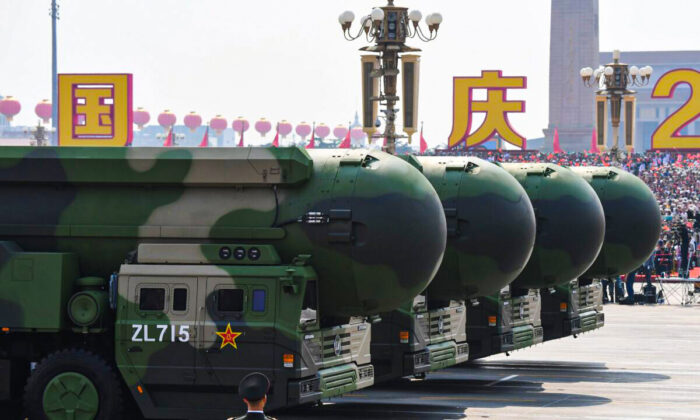China’s DF-41 nuclear-capable intercontinental ballistic missiles are seen during a military parade at Tiananmen Square in Beijing, China, on Oct. 1, 2019. (Greg Baker/AFP via Getty Images)
China Developing Nuclear Arsenal ‘for Global Domination’: Expert
By Andrew Thornebrooke and David Zhang
April 19, 2022 Updated: April 19, 2022
The Chinese Communist Party (CCP) is building up its nuclear arsenal as part of a greater effort to undermine the West and create a new international order in its own image, according to one expert.
“I don’t think [China is] building up its forces just for the deterrence factor,” said Peter Pry, Director of the U.S. nuclear strategy forum at the Center for Security Policy, a Washington-based think tank.
“I think it’s building up its nuclear forces for global domination.”
Pry made the comments during a recent interview with EpochTV’s “China Insider.” He said that U.S. leadership was too slow in adapting to the evolving threat of the CCP, in no small part because of the deep financial ties many American businesses have with China.
“We have been very slow to realize the consequences of neglecting our nuclear forces, and only now we’re waking up waking up to it,” Pry said.
“Many in Washington are still reluctant to accept that reality because many fortunes have been made in the West based on trade with China.”
Pry said that the CCP was playing a long strategic game with the buildup and modernization of its nuclear forces. A key goal of China’s nuclear program, he said, was to ensure that China could overcome Russia in the distant future, after the two nations’ partnership had pushed the United States out of its global leadership role.
“They don’t want to be inferior to Russia or anyone in their nuclear capabilities,” Pry said. “That’s why they’re building it up. It’s not just over Taiwan. It’s taking the long view. It’s looking at the strategic balance of power.”
Russia currently has the largest nuclear arsenal in the world, with around 1,500 deployed nuclear weapons and 6,257 warheads in total. The United States is next, with about 1400 deployed systems and 5,550 warheads in total. Between 1,500-2,000 warheads in both nations’ arsenals are retired and awaiting disarmament.
China, meanwhile, is currently reported to have around 350 warheads, but a recent Pentagon report warned that the CCP was drastically increasing production and modernization of its nuclear arsenal, and that it would have 1,000 nuclear weapons by 2030.
Pry believes that estimate to be far too low, and said he expected the real number of Chinese warheads to reach around 4,000 by 2030, based on the speed with which the CCP is constructing new intercontinental ballistic missiles (ICBM) and silos, and producing uranium.
That push toward nuclear proliferation and eventual dominance was important, Pry said, because Chinese communist leadership did not share the United States’ aversion to initiating nuclear conflict.
“I think the West is extremely dangerous and delusional in thinking that Russian and Chinese strategic culture is the same as ours, that they share the same view as we do about nuclear weapons being unusable, that you can’t fight and win a nuclear war,” Pry said.
“I think the problem is a profound difference in the strategic cultures of authoritarian and totalitarian states versus free societies, democracies, like the United States. Our strategic culture is one of what I would call ‘dysfunctional optimism’. You know, we always look at the best possible outcome.”
The CCP formally maintains a policy of no first use, meaning that it has vowed not to initiate nuclear conflict and to never use nuclear weapons against non-nuclear states.
The regime’s purported dedication to this vow has been increasingly questioned, however.
The Pentagon’s aforementioned report on CCP nuclear proliferation found that Chinese strategists had debated the merits of nuclear first use, and Pry noted that Chinese state media had threatened both Australia and Japan with nuclear aggression in recent months.
Pry warned that the United States had taken a “30 year holiday” in modernizing its own nuclear arsenal, thus providing China and Russia the time needed to develop strategic capabilities capable of matching or overcoming U.S. defenses, such as the CCP’s test of a nuclear capable hypersonic weapon system in July of last year.
“All the [U.S.] delivery systems or submarines or ICBMs or bombers date back to Ronald Reagan or before,” Pry said. “We’re living off the legacy of 30, 40, 50 years ago in terms of both our nuclear delivery systems and of the weapons themselves.”
“We are in a situation where nuclear war is not just a theoretical thing anymore,” Pry said. “We desperately need to get back from the edge of that.”

No comments:
Post a Comment